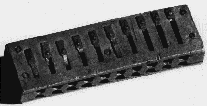Harmonica
Description
A harmonica is a wind instrument which emits sounds by the vibration of little blades or metal reeds. Each hole of the instrument can be used to make from 2 to 4 different notes. A different blade (i.e. a different pitch) is selected according to whether the performer blows or draws in the hole.
To select a given hole, the performer covers unwanted
holes with his tongue. He can also blow or draw in several holes at the same
time, to play a chord.
When blowing or drawing in several consecutive holes, the
performer can cover one or several contiguous holes so as not to play them.
Advanced techniques enable a blade to be played at a different and higher pitch than normal : this is the overbend.
Some harmonicas have 4 blades for each hole, and a bar called a slide enables the player to select the blades to use.
Harmonicas are split into two big families : chromatic and diatonic.
Chromatic harmonicas can play any semitone over several octaves, but the diatonic harmonica can only play a given set of notes. Diatonic harmonicas are tuned for a specific key, which is generally written on the top of the instrument.
History
The history of the harmonica, as we know it today, is an amazing tale which begins in the year 1821. It was then that sixteen-year-old Christian Friedrich Buschmann registered the first European patents for his new musical invention. His so-called "aura" was a free-reed instrument consisting of a series of steel reeds arranged together horizontally in small channels. An awkward design, it offered only blow notes arranged chromatically.
Buschmann described his new instrument to his brother as "a new instrument
that is truly remarkable. In its entirety it measures but four inches in
diameter...but gives me twenty-one notes, and all the pianissimos and crescendos
one could want without a keyboard, harmonies of six tones, and the ability to
hold a note as long as one would wish to."

Initial designs by Buschmann were widely imitated, leading to many modifications and advancements. A Bohemian instrument maker named Richter may have made the most important advancements in early harmonica design. Around 1826, he developed a variation that consisted of ten holes and twenty reeds, with separate blow and draw reed plates mounted on either side of a cedar comb. Richter's tuning, utilizing a diatonic scale, became the standard configuration of what Europeans referred to as the Mundharmonika or mouth organ.
In 1857, the history of the harmonica changed dramatically as German clock maker Matthias Hohner turned to manufacturing harmonicas full-time. With the help of his family and a hired workman, he was able to produce 650 instruments that year. Soon after, he added local workers and developed mass production techniques.
Young Hohner was an outstanding businessman and showed his marketing savvy by developing ornate cover plates bearing the producer's name.
He introduced the harmonica to North America in 1862, a move which would propel the Hohner company to its status as the world leader in harmonicas. By 1887, Hohner was producing more than one million harmonicas annually. Today, Hohner produces over 90 different models of harmonica, with a variety of styles and tunings which allows the player freedom of expression in all forms of music, from Classical and Jazz to Blues, Country and Rock, to the indigenous music of people worldwide.